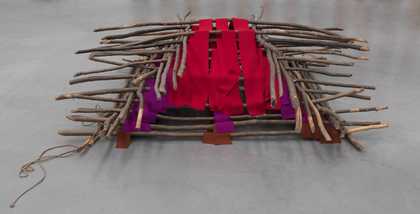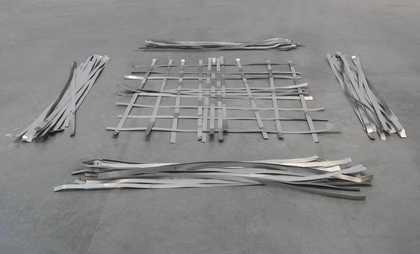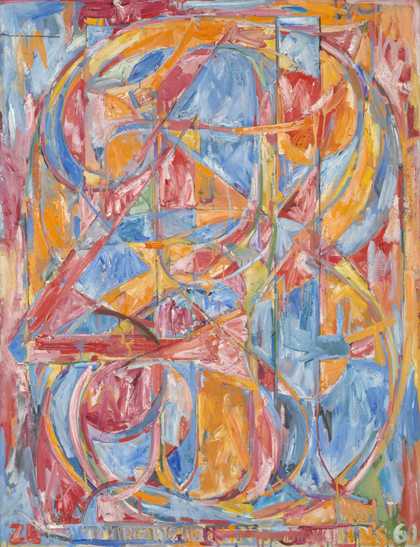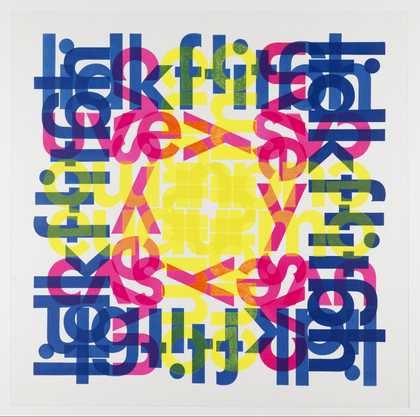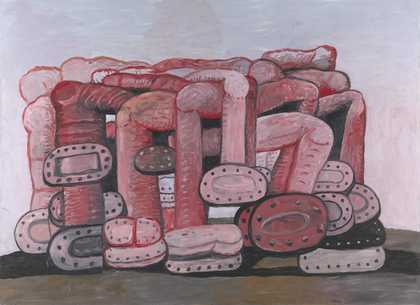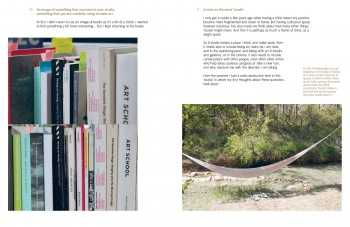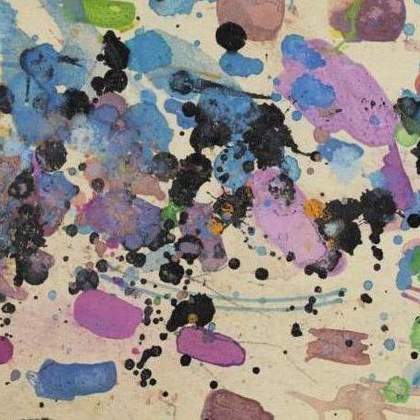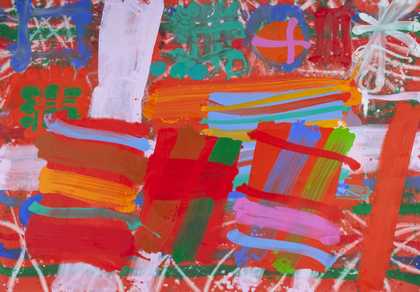
Albert Irvin OBE RA
St Germain (1995)
Tate
Introduction
'Interwoven' describes the process of weaving, meshing or combining different elements.
As a theme in art it can be explored in relation to the techniques artists use – the weaving of materials to create structures, reliefs or textured paintings. Ideas, experiences and relationships can also be interwoven to create artworks with richly layered meanings.
Weaving materials
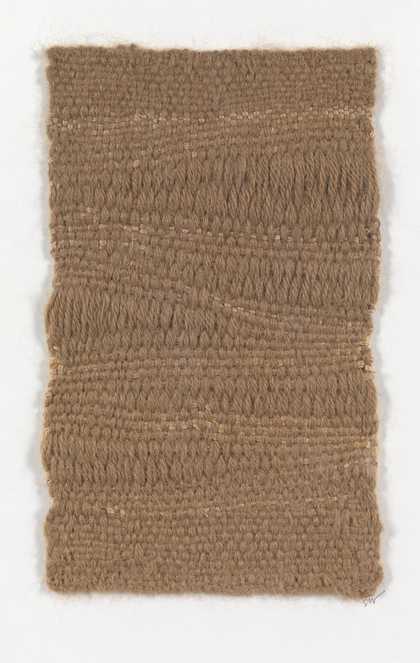
Sheila Hicks
Tacna-Arica (c.1957)
Tate
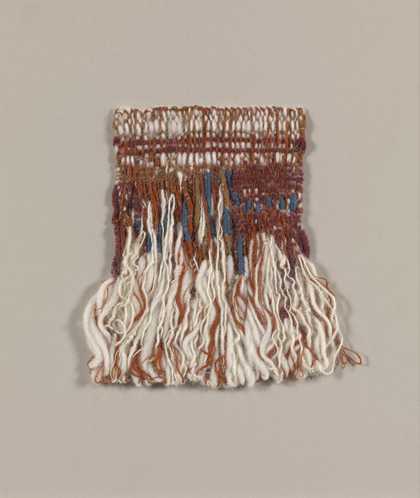
Sheila Hicks
Quipu de Cobré (1962)
Tate
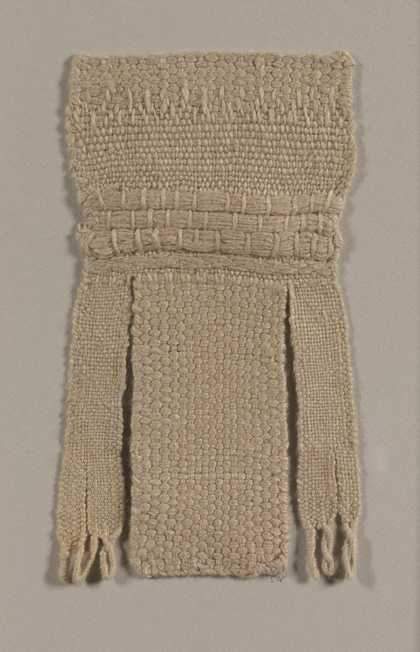
Sheila Hicks
Ganem (1968)
Tate
Can woven textiles be art? In the hands of Sheila Hicks, traditional weaving techniques inspired by South American culture and textiles, are used to create textured artworks. The lines and patterns of these miniature wall hangings remind us of abstract paintings. It isn’t only the techniques of traditional South American culture that she has incorporated into the work. For Tacna-Arica Hicks has combined the wool of a vicuña – a South American mammal similar to a Llama – with cotton yarn, creating a wavy-patterned panel that looks like a hilly landscape. As well as the cotton and wool yarns that we expect to see in woven textiles, Hicks has also interwoven transparent noodles, shirt collars, rubber bands and shoelaces into her artworks.
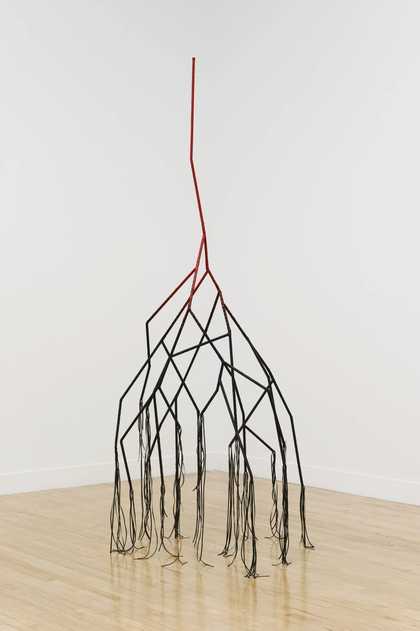
Eva Rothschild
Knock Knock (2005)
Tate
Artists Eva Rothschild and Barry Flanagan and Lee Ufan also interweave unlikely materials.
Rocthschild frequently combines industrial processes with craft techniques. Knock Knock 2005, an abstract structure that suggests branches or roots, is made from welded rods of steel. The hard steel rods are softened by a layer of woven leather that has been wrapped around them. The ends of the leather hang down in tassles that skim the floor and make the structure look as if it is magically floating.
Barry Flanagan made artworks that explored the sculptural potential of everyday objects and materials. no. 5 ‘71 1971 consists of forty-four tapering branches that have been layered and interwoven to create a ziggurat-like structure. Strips of felt and rope have been intertwined with the layers to add colour and texture.
The potential of unlikley materials is also something that Lee Ufan explores in his work Relatum 1968. The work references traditional weaving techniques, but rather than using flexible yarns he uses strips of metal. These have been woven to create a simple grid. Piles of metal strips lie beside the grid as if ready to be woven into it. Ufan often focuses on the nature of materials in his sculptures. By combining an unlikely material (metal) with a familiar technique (weaving) he makes us think about, and question, the properties of the metal and what it is potentially capable of. He presents an apparently unfinished artwork, leaving the question hanging: Can metal be woven? Will it work? This open-ended approach reflects East Asian philosophy which regards form and non-form, space and non-space, fullness and emptiness, not as rigid opposites but rather as dynamic concepts that are intertwined.
Weaving structures and architecture
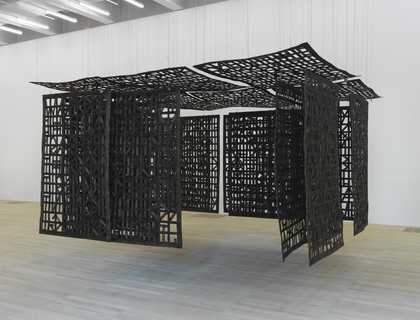
Cristina Iglesias
Pavilion Suspended in a Room I (2005)
Tate
Materials such as strips of wood or branches are often woven to create walls or fences.
The walls of Christina Iglesias's suspended pavilion look like the type of lattice fencing used in gardens. But as well as creating a structure, she also seems to be questioning the idea of structures. Structures are usually rooted on the ground, this one floats. Although made from braided metal, the structure seems fragile. This sense of fragility comes from the gaps and light that shines through the spaces of the weave. These patterns of light form an important part of the work. The gaps and spaces make it dysfunctional as a shelter. It depends on the larger enclosed gallery space that it is suspended in to offer the shelter which its title suggests.
Interwoven strips form the structure of Rasheed Araeen's Rang Baranga 1969. Before becoming an artist Araeen worked as an engineer, and the carefully constructed pillars of his sculpture reflect this engineering background. The geometric shapes formed by the interwoven strips of painted wood also suggest the repeated geometric patterns found in Islamic art and architecture in Araeen’s native Pakistan.
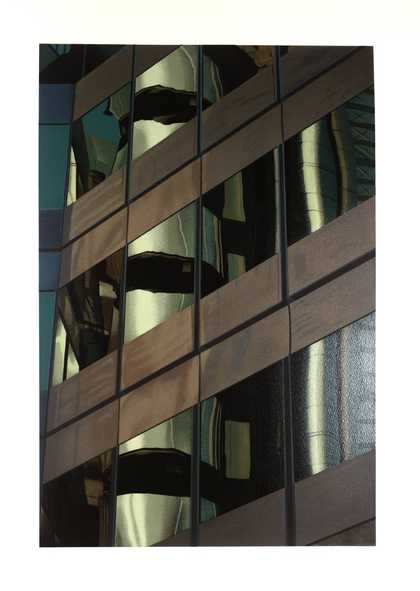
Brendan Neiland
Lloyd’s (1986)
Tate
Interwoven materials in architectural structures are also explored by artist Brendan Neiland in his series of prints inspired by modern buildings. He first discovered the Lloyds building while wandering around the City of London with his daughter on a quiet Sunday morning. He commented:
We were both staggered by a series of rippling, weaving and tubular reflections. Such a contrast to the ordered structure of so many buildings.
His print Lloyd's 1986 shows the building's architecture reflected in the glass windows of a building opposite. By focusing on a section of the building, the different materials of its structure form an abstract pattern of interweaving horizontal and vertical lines. The multiple squares of windows reflected in glass form a similarly interwoven pattern of lines in Neiland's print Tolmer Square 1981.
Weaving Paint and Pattern
So far this resource has looked at how artists physically weave materials to create three dimensional structures, and how the interweaving of materials can be seen in architecture. But artists also use the idea of weaving to create textured two-dimensional surfaces made from interwoven lines, shapes or images.
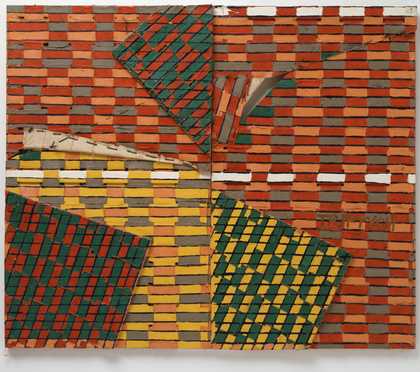
Stephen Buckley
Triptych (1974)
Tate

Frank Stella
Had Gadya: Back Cover (1982–4)
Tate
At first glance, Stehen Buckley’s Triptych 1974 looks as if it was made by weaving coloured strips. But he has used paint on canvas and wood to create the artwork. By repeating rectangular marks he mimics the appearance of basket weave. The peeled-back corners of the canvas surface add to the textile look of the painting.
The criss-crossing of marks and brushstrokes used by Albert Irvin to create his colourful abstract painting St Germain 1992 reminds us of woven fabric. As well expressive brush strokes, he has dribbled the paint onto the surface, and has also used squeegees and sponges to apply the paint.
Franks Stella’s print of interwoven patterns and shapes looks like a collage in its layering of different elements. Although made up of flat shapes, patterns and colour, this interweaving of layers gives the image a sense of three-dimensional depth.
Explore more paintings where the artists have interwoven painted marks, shapes and motifs:
Weaving Ideas, Stories and Histories
As well as interweaving materials, artists also interweave ideas, stories, histories and experiences to create artworks with powerful, richly layered meanings.
Interweaving ideas
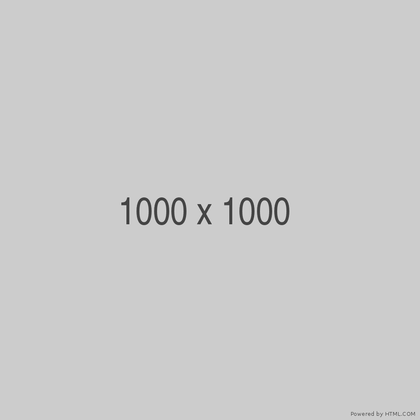
In Bruce Nauman's work VIOLINS VIOLENCE SILENCE 1981–2 the words ‘VIOLINS’, ‘VIOLENCE’, and ‘SILENCE’ are spelled out in coloured neon tubing. The words illuminate in a cycle which begins with them all lit up, then each lighting up in turn, before all lighting up together once more. As well as the words being interwoven visually in the work, the sound of each word if spoken out is also interwoven – it becomes a sort of visual sound poem. The meaning of the work is ambiguous. Curator Joseph D. Ketner II commented: ‘the word violin conjures up a pure musical sound that is squelched by violence and obliterated by the succeeding silence', suggesting that the work is about the extremes of music and silence, creativity and violence. What do you think?
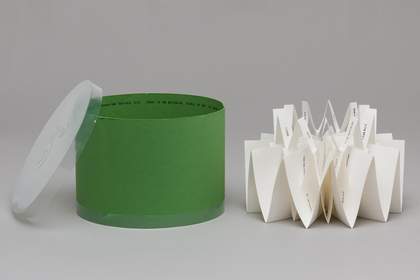
Mette-Sofie Ambeck 6 degrees of separation 2000
© Mette-Sofie Ambeck
Mette-Sofie Ambeck also creates an interwoven structure that reflects the meaning of the work. 6 degrees of separation is a structural book in a circular box that takes as its theme the theory of ‘six degrees of separation’. This is the theory that we are all connected via acquaintances and that any one person can be shown to be connected to any other person through a chain of no more than five people. This idea that our lives and stories are somehow interwoven is reflected in the structure Ambeck has used to create the book. It is made of three strips of paper of different widths. The strips have been folded and interwoven to create a tiered concertina-like structure. As the work is drawn from the box it expands, seeming to burst into life. The strips are rubber-stamped with text based on conversations recorded by the artist on trains on the Circle underground line in London. The text on the lid of the protective box reads: ‘The structure holds the book together whilst also illustrating the theory. No beginning, no end – everyone is connected in whatever direction the reader chooses ...'
Interweaving cultures and histories
Artist Chen Zhen lived and worked in Shanghai, New York and Paris, and his work reflects this constant shifting between cultures. In his sculptures and installations he often combined obsolete everyday objects, particularly old furniture and candles with fragments of technology and consumer goods. In this way he interwove symbols of the different cultures creating structures that reflect the interweaving of his experience of these cultures. This work belongs to a series of sculptures made between 1999 and 2000, sharing the title Cocon du Vide (‘empty cocoon’) and featuring chrysalis-like forms made from Chinese abacus and Buddhist rosary beads threaded onto metal frames.
Like Chen Zhen, Lubaina Himid also explores the interweaving of cultures that make up her identity. She was born in Zanzibar, which is part of Tanzania, but moved to England shortly after her birth. Her paintings, woodcuts, installations, works on paper and curatorial projects often emphasise the contribution of African migrants to the development of European culture. Carpet suggests patchwork and the idea that cloth can bear the traces of activities for which it is used. It is part of a series of works where she blends modernist abstraction and African textiles and traditions.
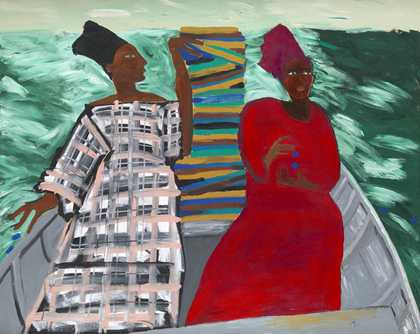
Lubaina Himid CBE RA
Between the Two my Heart is Balanced (1991)
Tate
© Lubaina Himid, courtesy the artist and Hollybush Gardens, London
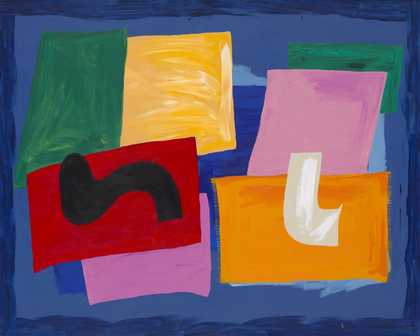
Lubaina Himid CBE RA
Carpet (1992)
Tate
© Lubaina Himid, courtesy the artist and Hollybush Gardens, London
Artist Chris Ofili was born in Britain and has Nigerian parents. He often interweaves motifs drawn from jazz and hip-hop, comic books, racial stereotypes, Catholicism (Ofili is a practicing Catholic), and African textiles into his richly textured paintings and prints. While some compositions are deliberately abstract, others include iconic black figures surrounded by abstract patterns. The combination of decorative style and social content is part of hisplayful exploration of issues relating to black identity.
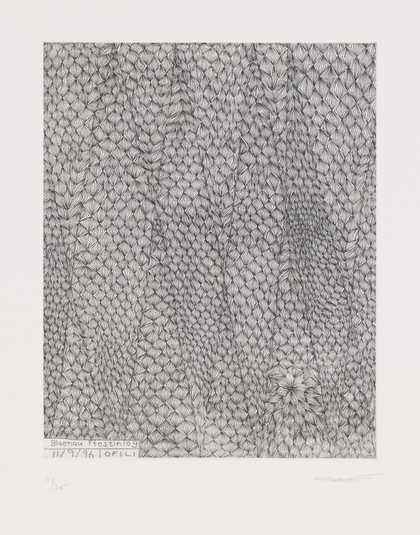
Chris Ofili
Blaenau Ffestiniog 11.9.96 (1996)
Tate
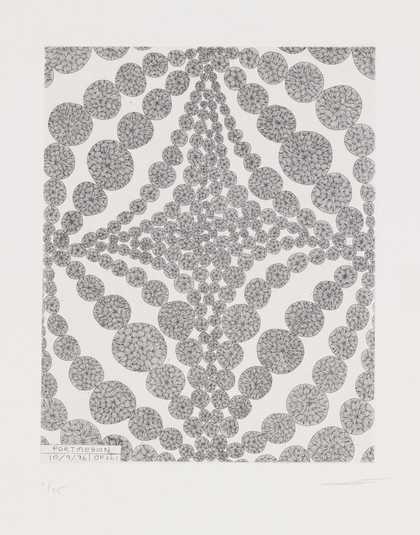
Chris Ofili
Portmerion 10.9.96 (1996)
Tate
The patterns in his series of abstract prints North Wales, suggest braided African hair. This series of etchings is one of four he made inspired by a particular trip. On each trip, Ofili took along a set of copper etching plates and, working methodically, used a different abstract pattern loosely related to his impressions of the specific place. He called his project 'an odd kind of tourism'.
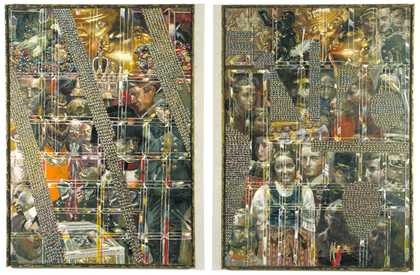
Leon Vilaincour
A Life (1984–5)
Tate
Polish artist Leon Vilaincour explores personal memories as well as broader themes of European history in his work – interweaving images, colours and patterns to form intricate compositions. The density of the two compositions that make up his artwork A Life 1984-5, along with the varying scales of the figures and their apparent disconnection from each other, give the work a collage-like appearance. He has described the title of the work as ‘very literal’, since many of the figures are representations of the artist’s friends and relatives, while others are individuals from history with whom he has felt some personal connection. By including these portraits, A Life, like many of Vilaincour’s paintings, combines aspects of the artist’s own background with references to the ways in which his family was affected by the military history of the twentieth century.
Interweaving relationships
As well as complex cultural identities, artists have often been inspired by the interweaving of their relationships with others.
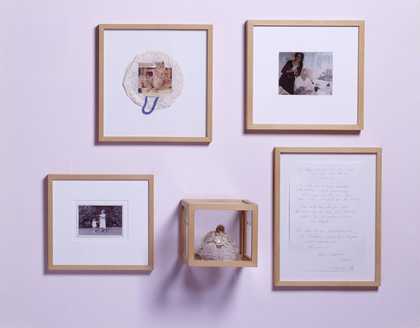
Tracey Emin
May Dodge, My Nan (1963–93)
Tate
In May Dodge, My Nan Tracey Emin pays tribute to her close relationship with her grandmother. The piece is formed of five separate elements, including photographs and a handmade pomander, made by Emin's grandmother. Although the elements that make up the work are framed separately, they are interwoven through Emin's memories of her nan. In her artworks, Emin often uses displays of objects or 'relics' that focus on her intimate personal relationships and significant events in her life. They frequently include text, always in her signature handwriting, which introduces a narrative voice explaining the objects’ emotional meaning for her. A page of handwritten text included in this work pays tribute to her loving relationship with her grandmother. It reads:
May Dodge - My Nan She’s 92 I call/ her Plum She calls me/ Pudding - / She made me the most beautiful/ baby clothes – white crocheted/ she made them for me a few/ years ago – She said at the time/ “I’ve made them for you now/ because – by the time you have a/ baby – I’ll be making clothes/ for angels./ Dear Nanny I’m not afraid anymore - / Life’s fantastic – who’d have thought/ I could make angels - /for you - / They’re waiting/ XXX
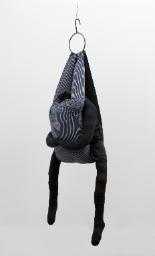
Louise Bourgeois
Couple I (1996)
ARTIST ROOMS
Tate and National Galleries of Scotland. Lent by Artist Rooms Foundation 2013
Artist Louise Bourgeois also uses her memories of relationships in her work. These relate mainly to memories of her relationship with her parents and their relationship with each other. Through these she explores themes including gender, sex and mortality.
The couple represented in this hanging sculpture are intertwined and appear to merge into each other. As in many of Bourgeois’s works, male and female are combined in an ambiguous arrangement of body parts. For Bourgeois, hanging indicates a state of uncertainty. ‘Horizontality is a desire to give up, to sleep’, she said. ‘Verticality is an attempt to escape. Hanging and floating are states of ambivalence.’
In this video, Louise Bourgeois discusses the relationships that were such a powerful influence on her ideas and art.
This film file is broken and is being removed. Sorry for any inconvenience this causes.

